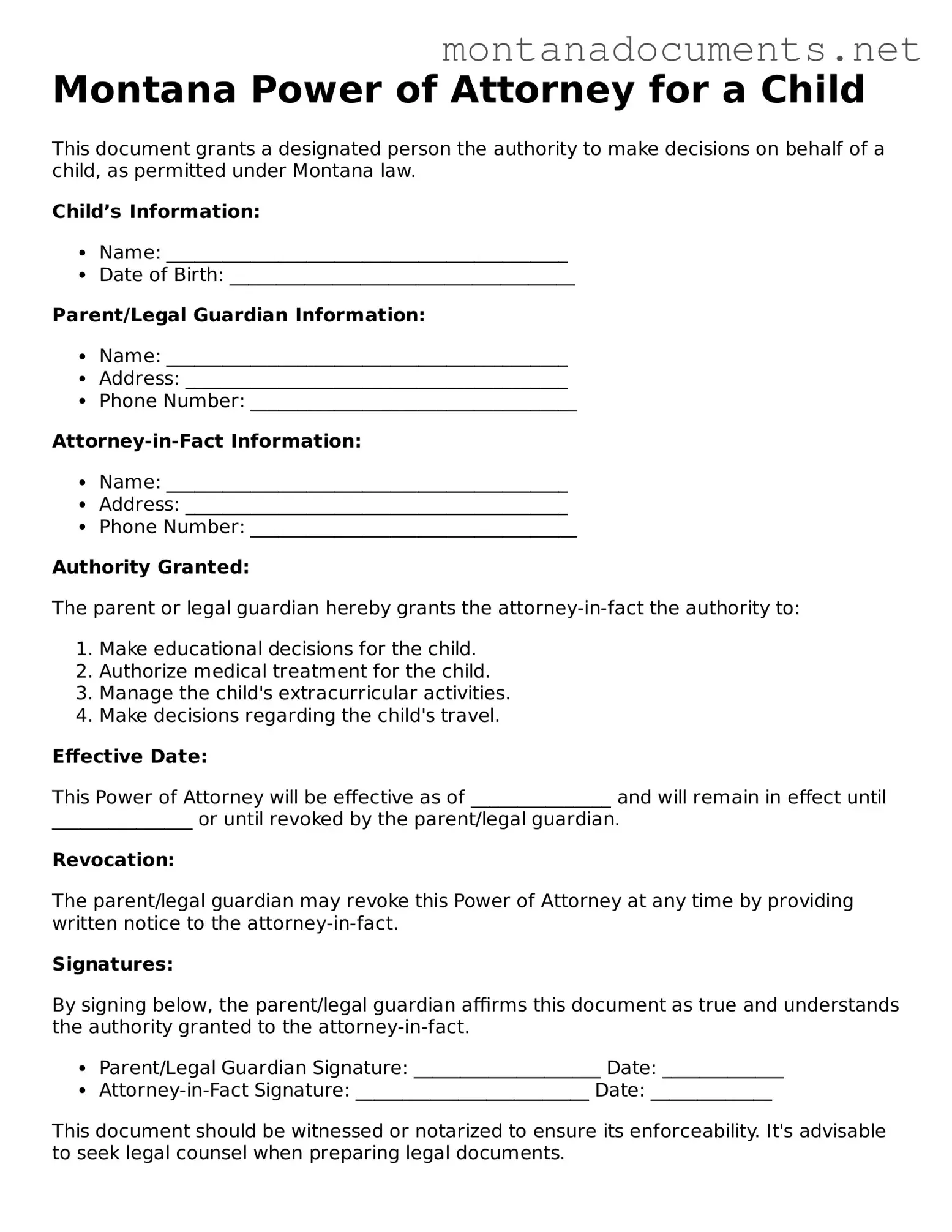The Montana Power of Attorney for a Child form shares similarities with the General Power of Attorney. Both documents grant authority to an individual to act on behalf of another person. However, while the General Power of Attorney can be used for a wide range of decisions—financial, legal, and personal—the Power of Attorney for a Child specifically focuses on decisions related to the care and custody of a minor child. This targeted approach ensures that the designated agent can make informed choices about the child's welfare, education, and medical needs.
Another document that is comparable is the Medical Power of Attorney. This form allows a designated person to make medical decisions on behalf of another individual if they become unable to do so. Similar to the Power of Attorney for a Child, the Medical Power of Attorney is focused on specific aspects of care. However, it is primarily concerned with health care decisions rather than broader responsibilities like education or daily living. Both documents empower a trusted individual to act in the best interest of another, ensuring that their needs are met when they cannot advocate for themselves.
The Temporary Guardianship Agreement is also akin to the Power of Attorney for a Child. This document allows a parent or legal guardian to designate another adult to care for their child for a limited time. Like the Power of Attorney for a Child, it is intended to ensure that a child’s needs are met when the parent is unavailable. However, the Temporary Guardianship Agreement typically has a set expiration date, while the Power of Attorney can remain in effect until revoked or until a specified condition is met.
Similar to these documents is the Standby Guardian Designation. This form allows a parent to name a standby guardian who can assume responsibility for their child in the event of an emergency or incapacity. The Power of Attorney for a Child serves a similar purpose, granting authority to make decisions when the parent is not available. However, the Standby Guardian Designation is specifically intended for situations where the parent anticipates being unable to care for the child, providing a proactive solution for temporary care.
Understanding legal documents related to child custody and guardianship can be complex, but resources like the onlinelawdocs.com/ provide valuable information to help navigate these processes effectively.
The Child Custody Agreement also bears resemblance to the Power of Attorney for a Child. This legal document outlines the terms of custody and visitation between parents or guardians. While the Power of Attorney for a Child allows a designated person to make decisions on behalf of the child, the Child Custody Agreement focuses on the arrangement of living situations and parental responsibilities. Both documents aim to protect the child's best interests, but they serve different legal purposes in the context of parental rights and responsibilities.
Another related document is the Consent for Medical Treatment form. This form allows a parent or guardian to authorize medical treatment for their child when they are not present. Like the Power of Attorney for a Child, it ensures that the child receives necessary care in the absence of a parent. However, the Consent for Medical Treatment is typically limited to medical decisions, whereas the Power of Attorney for a Child encompasses a broader range of responsibilities, including educational and daily living decisions.
The Affidavit of Custodian can also be compared to the Power of Attorney for a Child. This document is often used to confirm that a person has the authority to make decisions for a child in the absence of a parent. It serves as a legal acknowledgment of the custodial relationship. While both documents provide a framework for decision-making, the Affidavit of Custodian is often used in more informal situations, whereas the Power of Attorney for a Child is a more formalized legal arrangement.
The Child Care Authorization form is another document that has similarities. This form allows a parent to authorize another adult to care for their child temporarily. It is often used for short-term situations, such as babysitting or school events. While the Power of Attorney for a Child grants broader authority for decision-making, the Child Care Authorization is more limited in scope, focusing primarily on day-to-day care and supervision.
The Release of Liability form is also somewhat similar. This document is often used in situations where a parent allows their child to participate in activities that may involve some risk. By signing this form, the parent acknowledges the risks and releases the organization from liability. While the Power of Attorney for a Child does not specifically address liability, it empowers the designated agent to make decisions regarding the child's participation in such activities, ensuring that appropriate care and supervision are in place.
Finally, the Adoption Consent form is comparable in that it involves the legal rights of a child. This document allows biological parents to consent to the adoption of their child by another individual or couple. While the Power of Attorney for a Child does not terminate parental rights, it temporarily transfers certain decision-making powers to another person. Both documents highlight the importance of ensuring that a child's best interests are prioritized, whether through temporary delegation of authority or through a permanent change in guardianship.
